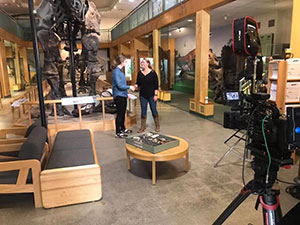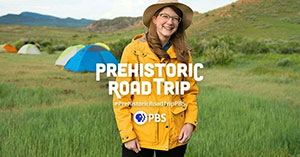UW Faculty, Students and Alumni to Appear on PBS Series Prehistoric Road Trip
Published June 15, 2020

University of Wyoming faculty members Ellen Currano and Laura Vietti, students and alumni will take viewers to another era as part of “Prehistoric Road Trip.” The three-part natural history series -- that explores prehistoric life in the western United States -- premieres Wednesday, June 17, on Chicago’s PBS station, WTTW.
Each of the three episodes will examine different eras in time, focusing on geology, ecology and the environment, to understand what the United States looked like millions and even billions of years ago. The series will explore 2.5 billion years of Earth’s history through paleontology and fossil hunting -- from North American dinosaurs to ancient fishes, mammoths and early mammals.
“The Department of Geology and Geophysics and, of course, the state of Wyoming are very well represented in this miniseries,” says Currano, an associate professor in the UW departments of Botany, and Geology and Geophysics.
Currano says UW alumna Kelli Trujillo, an instructor of science/developmental math at Laramie County Community College, leads a tour of the stromatolites in the Snowy Range during Episode 1. Vietti, UW Geological Museum and collections manager, shows off the museum collections in Episode 3. Additionally, Lauren Azevedo Schmidt, a UW Ph.D. student in the Program in Ecology, from Chico, Calif.; UW alumna Regan Dunn, assistant curator at La Brea Tar Pits & Museum in Los Angeles; and Currano will show off their Hanna Basin Paleocene Eocene Thermal Maximum (PETM) research in Episode 3.
“I mostly discussed the role fossil teeth play in paleontology,” Vietti says of her upcoming segment about a grant she received to digitally image small fossil teeth. “Teeth are like a paleontological gold mine. They provide information about the animal’s taxonomy, size, geochronology, age at death, diet, niche, life history, last meals, etc. Moreover, the minerals they are made of can provide information about the climate, diet, trophic levels and more.
“But, most fossil teeth in the early Cenozoic are quite small, like the size of a pin head and difficult to image, so we have a specialized digitization station capable of imaging small fossil teeth at very high magnification for sharing with the scientific and public communities.”
During her segment, Currano says she and her colleagues study how landscapes in the Hanna Basin changed during the PETM, a past global warming event that took place 56 million years ago.
“We excavate plant fossils and study them (number of plant species, size and shape of the leaves) to understand how vegetation changed, and also to interpret climate changes,” she says. “We even look at ancient bug bites on the fossil leaves to study how insect herbivores were affected. My close colleague, Marieke Dechesne at the U.S. Geological Survey, is interested in how vegetation changes affected river systems.”
Emily Graslie, chief curiosity correspondent at the Field Museum in Chicago and the creator of the popular YouTube series “The Brain Scoop,” hosts the series. Graslie and a WTTW crew took a road trip and filmed around Montana, Nebraska, Wyoming and the Dakotas, where Graslie grew up. She filmed segments with UW personnel in summer 2019, Currano says.

Currano received an invitation to present a science talk and host a “Bearded Lady Project” film screening at the Field Museum in June 2018. Currano, a longtime fan of Graslie’s work, had the opportunity to meet with her. It turns out Graslie wanted to meet with Currano to discuss her new project, “Prehistoric Road Trip.” Through a series of subsequent phone calls, Currano told Graslie of potential filming opportunities with UW faculty, students and alumni on campus and around Wyoming.
To catch the episodes, watch on PBS stations nationwide Wednesdays, June 17 and 24, and July 1 at 9 p.m. MDT; or stream on www.wttw.com/prehistoricroadtrip, on PBS member station websites and on the PBS app.
Beyond the three broadcast episodes, WTTW will provide extra opportunities for audiences to dive into “Prehistoric Road Trip” via a companion website at www.wttw.com/prehistoricroadtrip. The companion site will feature original digital content, behind-the-scenes travel journals and an interactive road trip map.
“My personal hope is that the audience learns that you don’t have to do paleontology at a large famous museum like the Smithsonian or Denver Museum of Nature & Science,” Vietti says. “There’s a variety of smaller museums hosting incredible researchers who are everyday people like the audience of the show, and I hope the audience will be inspired to visit these smaller museums as well to see just how approachable and cool the entire fossil record is.”
Currano shares similar sentiments, stressing that women can be paleontologists in what is traditionally a field dominated by men.
“A really important message I want conveyed is that anyone can do science. Growing up, all I ever saw were dinosaur documentaries with a bunch of white men, hosted by white men,” Currano says. “One night, after dinner, the film crew and our science team were walking in the badlands. The sun was low, and the light was beautiful.
“Emily was wearing this brilliant yellow raincoat and had her hair in a ponytail. And I started tearing up because I had never seen someone who looked like me hosting a major science documentary! And our Hanna Basin science team of four women would be featured!”

